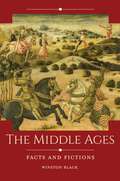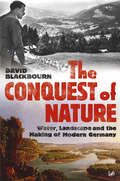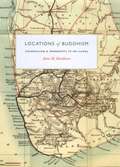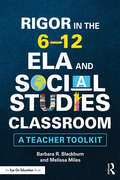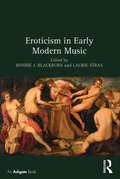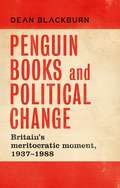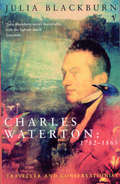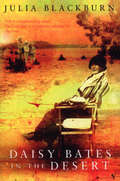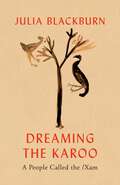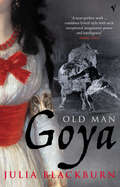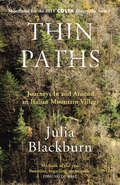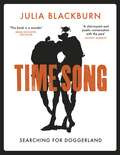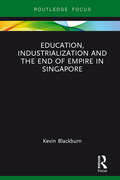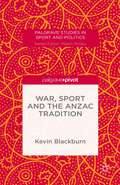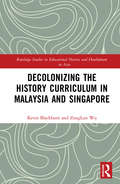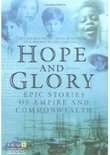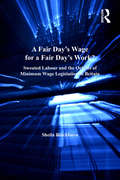- Table View
- List View
The Middle Ages: Facts and Fictions (Historical Facts and Fictions)
by Winston BlackThis book guides readers through 10 pervasive fictions about medieval history, provides them with the sources and analytical tools to critique those fictions, and identifies what really happened in the Middle Ages.This book is the first to present fictions about the medieval world to serious students of history. Instead of merely listing myths and stating they are wrong, this volume promotes critical historical analysis of those myths and how they came to be. Each of the ten chapters outlines a pervasive modern myth about medieval European history, describing "What People Think Happened" and "What Really Happened," and illustrating both trends with primary source documents.The book demonstrates that historical fictions also have a history, and that while we need to replace those fictions with facts about the medieval past, we can also benefit from understanding how a fiction about the Middle Ages developed and what that says about our modern perspectives on the past. Through this innovative presentation, readers are introduced to a wide range of sources, from Roman imperial perspectives on the "Fall of Rome" to songs of chivalry and chronicles of the Crusades, scientific treatises on the shape of the Earth and the creation of the universe and early modern stories and textbooks that developed or perpetuated historical myths.
The Conquest Of Nature: Water, Landscape, and the Making of Modern Germany
by David BlackbournThe modern idea of 'mastery' over nature always had its critics, whether their motives were aesthetic, religious or environmentalist. By investigating how the most fundamental element - water - was 'conquered' by draining fens and marshes, straightening the courses of rivers, building high dams and exploiting hydro-electric power, The Conquest of Nature explores how over the last 250 years, the German people have shaped their natural environment and how the landscapes they created took a powerful hold on the German imagination. From Frederick the Great of Prussia to Johann Gottfried Tulla, 'the man who tamed the wild Rhine' in the nineteenth century to Otto Intze, 'master dambuilder' of the years around 1900, to the Nazis who set out to colonise 'living space' in the East, this groundbreaking study shows that while mastery over nature delivers undoubted benefits, it has often come at a tremendous cost to both the natural environment and human life.
Locations of Buddhism: Colonialism and Modernity in Sri Lanka (Buddhism and Modernity)
by Anne M. BlackburnModernizing and colonizing forces brought nineteenth-century Sri Lankan Buddhists both challenges and opportunities. How did Buddhists deal with social and economic change; new forms of political, religious, and educational discourse; and Christianity? And how did Sri Lankan Buddhists, collaborating with other Asian Buddhists, respond to colonial rule? To answer these questions, Anne M. Blackburn focuses on the life of leading monk and educator Hikkaduve Sumangala (1827–1911) to examine more broadly Buddhist life under foreign rule. In Locations of Buddhism, Blackburn reveals that during Sri Lanka’s crucial decades of deepening colonial control and modernization, there was a surprising stability in the central religious activities of Hikkaduve and the Buddhists among whom he worked. At the same time, they developed new institutions and forms of association, drawing on pre-colonial intellectual heritage as well as colonial-period technologies and discourse. Advocating a new way of studying the impact of colonialism on colonized societies, Blackburn is particularly attuned here to human experience, paying attention to the habits of thought and modes of affiliation that characterized individuals and smaller scale groups. Locations of Buddhism is a wholly original contribution to the study of Sri Lanka and the history of Buddhism more generally.
Locations of Buddhism: Colonialism and Modernity in Sri Lanka (Buddhism and Modernity)
by Anne M. BlackburnModernizing and colonizing forces brought nineteenth-century Sri Lankan Buddhists both challenges and opportunities. How did Buddhists deal with social and economic change; new forms of political, religious, and educational discourse; and Christianity? And how did Sri Lankan Buddhists, collaborating with other Asian Buddhists, respond to colonial rule? To answer these questions, Anne M. Blackburn focuses on the life of leading monk and educator Hikkaduve Sumangala (1827–1911) to examine more broadly Buddhist life under foreign rule. In Locations of Buddhism, Blackburn reveals that during Sri Lanka’s crucial decades of deepening colonial control and modernization, there was a surprising stability in the central religious activities of Hikkaduve and the Buddhists among whom he worked. At the same time, they developed new institutions and forms of association, drawing on pre-colonial intellectual heritage as well as colonial-period technologies and discourse. Advocating a new way of studying the impact of colonialism on colonized societies, Blackburn is particularly attuned here to human experience, paying attention to the habits of thought and modes of affiliation that characterized individuals and smaller scale groups. Locations of Buddhism is a wholly original contribution to the study of Sri Lanka and the history of Buddhism more generally.
Locations of Buddhism: Colonialism and Modernity in Sri Lanka (Buddhism and Modernity)
by Anne M. BlackburnModernizing and colonizing forces brought nineteenth-century Sri Lankan Buddhists both challenges and opportunities. How did Buddhists deal with social and economic change; new forms of political, religious, and educational discourse; and Christianity? And how did Sri Lankan Buddhists, collaborating with other Asian Buddhists, respond to colonial rule? To answer these questions, Anne M. Blackburn focuses on the life of leading monk and educator Hikkaduve Sumangala (1827–1911) to examine more broadly Buddhist life under foreign rule. In Locations of Buddhism, Blackburn reveals that during Sri Lanka’s crucial decades of deepening colonial control and modernization, there was a surprising stability in the central religious activities of Hikkaduve and the Buddhists among whom he worked. At the same time, they developed new institutions and forms of association, drawing on pre-colonial intellectual heritage as well as colonial-period technologies and discourse. Advocating a new way of studying the impact of colonialism on colonized societies, Blackburn is particularly attuned here to human experience, paying attention to the habits of thought and modes of affiliation that characterized individuals and smaller scale groups. Locations of Buddhism is a wholly original contribution to the study of Sri Lanka and the history of Buddhism more generally.
Locations of Buddhism: Colonialism and Modernity in Sri Lanka (Buddhism and Modernity)
by Anne M. BlackburnModernizing and colonizing forces brought nineteenth-century Sri Lankan Buddhists both challenges and opportunities. How did Buddhists deal with social and economic change; new forms of political, religious, and educational discourse; and Christianity? And how did Sri Lankan Buddhists, collaborating with other Asian Buddhists, respond to colonial rule? To answer these questions, Anne M. Blackburn focuses on the life of leading monk and educator Hikkaduve Sumangala (1827–1911) to examine more broadly Buddhist life under foreign rule. In Locations of Buddhism, Blackburn reveals that during Sri Lanka’s crucial decades of deepening colonial control and modernization, there was a surprising stability in the central religious activities of Hikkaduve and the Buddhists among whom he worked. At the same time, they developed new institutions and forms of association, drawing on pre-colonial intellectual heritage as well as colonial-period technologies and discourse. Advocating a new way of studying the impact of colonialism on colonized societies, Blackburn is particularly attuned here to human experience, paying attention to the habits of thought and modes of affiliation that characterized individuals and smaller scale groups. Locations of Buddhism is a wholly original contribution to the study of Sri Lanka and the history of Buddhism more generally.
Rigor in the 6–12 ELA and Social Studies Classroom: A Teacher Toolkit
by Barbara R. Blackburn Melissa MilesLearn how to incorporate rigorous activities in your English language arts or social studies classroom and help students reach higher levels of learning. Expert educators and consultants Barbara R. Blackburn and Melissa Miles offer a practical framework for understanding rigor and provide specialized examples for middle and high school ELA and social studies teachers. Topics covered include: Creating a rigorous environment High expectations Support and scaffolding Demonstration of learning Assessing student progress Collaborating with colleagues The book comes with classroom-ready tools, offered in the book and as free eResources on our website at www.routledge.com/9781138480773.
Rigor in the 6–12 ELA and Social Studies Classroom: A Teacher Toolkit
by Barbara R. Blackburn Melissa MilesLearn how to incorporate rigorous activities in your English language arts or social studies classroom and help students reach higher levels of learning. Expert educators and consultants Barbara R. Blackburn and Melissa Miles offer a practical framework for understanding rigor and provide specialized examples for middle and high school ELA and social studies teachers. Topics covered include: Creating a rigorous environment High expectations Support and scaffolding Demonstration of learning Assessing student progress Collaborating with colleagues The book comes with classroom-ready tools, offered in the book and as free eResources on our website at www.routledge.com/9781138480773.
Eroticism in Early Modern Music
by Bonnie Blackburn Laurie StrasEroticism in Early Modern Music contributes to a small but significant literature on music, sexuality, and sex in sixteenth- and seventeenth-century Europe. Its chapters have grown from a long dialogue between a group of scholars, who employ a variety of different approaches to the repertoire: musical and visual analysis; archival and cultural history; gender studies; philology; and performance. By confronting musical, literary, and visual sources with historically situated analyses, the book shows how erotic life and sensibilities were encoded in musical works. Eroticism in Early Modern Music will be of value to scholars and students of early modern European history and culture, and more widely to a readership interested in the history of eroticism and sexuality.
Eroticism in Early Modern Music
by Bonnie Blackburn Laurie StrasEroticism in Early Modern Music contributes to a small but significant literature on music, sexuality, and sex in sixteenth- and seventeenth-century Europe. Its chapters have grown from a long dialogue between a group of scholars, who employ a variety of different approaches to the repertoire: musical and visual analysis; archival and cultural history; gender studies; philology; and performance. By confronting musical, literary, and visual sources with historically situated analyses, the book shows how erotic life and sensibilities were encoded in musical works. Eroticism in Early Modern Music will be of value to scholars and students of early modern European history and culture, and more widely to a readership interested in the history of eroticism and sexuality.
Penguin Books and political change: Britain's meritocratic moment, 1937–1988
by Dean BlackburnFounded in 1935 by a young publisher disillusioned with the class prejudices of the interwar publishing trade, Penguin Books set out to make good books available to all. The ‘Penguin Specials’, a series of current affairs books authored by leading intellectuals and politicians, embodied its democratising mission. Published over fifty years and often selling in vast quantities, these inexpensive paperbacks helped to shape popular ideas about subjects as varied as the welfare state, homelessness, social class and environmental decay. Using the ‘Specials’ as a lens through which to view Britain’s changing political landscape, Dean Blackburn tells a story about the ideas that shaped post-war Britain. Between the late-1930s and the mid-1980s, Blackburn argues, Britain witnessed the emergence and eclipse of a ‘meritocratic moment’, at the core of which was the belief that a strong relationship between merit and reward would bring about social stability and economic efficiency. Equal opportunity and professional expertise, values embodied by the egalitarian aspirations of Penguin’s publishing ethos, would be the drivers of social and economic progress. But as the social and economic crises of the 1970s took root, many contemporary thinkers and politicians cast doubt on the assumptions that informed meritocratic logic. Britain’s meritocratic moment had passed.
Penguin Books and political change: Britain's meritocratic moment, 1937–1988
by Dean BlackburnFounded in 1935 by a young publisher disillusioned with the class prejudices of the interwar publishing trade, Penguin Books set out to make good books available to all. The ‘Penguin Specials’, a series of current affairs books authored by leading intellectuals and politicians, embodied its democratising mission. Published over fifty years and often selling in vast quantities, these inexpensive paperbacks helped to shape popular ideas about subjects as varied as the welfare state, homelessness, social class and environmental decay. Using the ‘Specials’ as a lens through which to view Britain’s changing political landscape, Dean Blackburn tells a story about the ideas that shaped post-war Britain. Between the late-1930s and the mid-1980s, Blackburn argues, Britain witnessed the emergence and eclipse of a ‘meritocratic moment’, at the core of which was the belief that a strong relationship between merit and reward would bring about social stability and economic efficiency. Equal opportunity and professional expertise, values embodied by the egalitarian aspirations of Penguin’s publishing ethos, would be the drivers of social and economic progress. But as the social and economic crises of the 1970s took root, many contemporary thinkers and politicians cast doubt on the assumptions that informed meritocratic logic. Britain’s meritocratic moment had passed.
Charles Waterton 1782-1865: Traveller and Conservationist
by Julia BlackburnCharles Waterton was the first conservationist who fought to protect wild nature against the destruction and pollution of Victorian industrialisation. During his lifetime he was famous for his eccentricities, but also for his achievements and his opinions. A Yorkshire landowner, he turned his park into a sanctuary for animals and birds. As an explorer he learned to survive in the tropical rain forests of South America without a gun or the society of other white men. He was an authority on the poisons used by South American Indians and a taxidermist of note. The huge public that read his books included Dickens, Darwin and Roosevelt. Since his death the memory of Waterton's personal eccenticities has flourished, while the originality of his ideas and work has often suffered. Using his surviving papers, Julia Blackburn has redressed the balance in a biogr aphy that restores Waterton to his place as the first conservationist of the modern age.
Daisy Bates In The Desert: A Woman's Life Among The Aborigines
by Julia BlackburnIn 1913, when she was 54 years old, Daisy Bates went to live in the deserts of South Australia. And there she stayed, with occasional interruptions, for almost 30 years. In Daisy Bates in the Desert Julia Blackburn explores the ancient and desolate landscape where Ms Bates says she was most happy. She fuses her own imagination and experience with that of Daisy Bates, unitl she seems to be recalling this other life as it it were her own.
Dreaming the Karoo: A People Called the /Xam
by Julia BlackburnA spellbinding new book by the much-acclaimed writer, a journey to South Africa in search of the lost people called the /Xam - a haunting book about the brutality of colonial frontiers and the fate of those they dispossess.In spring 2020, Julia Blackburn travelled to the Karoo region of South Africa to see for herself the ancestral lands that had once belonged to an indigenous group called the /Xam.Throughout the nineteenth century the /Xam were persecuted and denied the right to live in their own territories. In the 1870s, facing cultural extinction, several /Xam individuals agreed to teach their intricate language to a German philologist and his indomitable English sister-in-law. The result was the Bleek-Lloyd Archive: 60,000 notebook pages in which their dreams, memories and beliefs, alongside the traumas of their more recent history, were meticulously recorded word for word. It is an extraordinary document which gives voice to a way of living in the world which we have all but lost. 'All things were once people', the /Xam said.Blackburn's journey to the Karoo was cut short by the outbreak of the global pandemic, but she had gathered enough from reading the archive, seeing the /Xam lands and from talking to anyone and everyone she met along the way, to be able to write this haunting and powerful book, while living her own precarious lockdown life. Dreaming the Karoo is a spellbinding new masterpiece by one of our greatest and most original non-fiction writers.
Old Man Goya
by Julia BlackburnIn 1792, when he was forty-seven, the Spanish painter Francisco de Goya contracted a serious illness which left him stone deaf. In this extraordinary book Julia Blackburn follows Goya through the remaining thirty-five years of his life. It was a time of political turmoil, of war, violence and confusion, and Goya transformed what he saw happening in the world around him into his visionary paintings, drawings and etchings. These were also years of tenderness for Goya, of intimate relationships with the Duchess of Alba and with Leocadia, his mistress, who was with him to the end. Julia Blackburn writes of the elderly painter with the intimacy of an old friend, seeing through his eyes and sharing the silence in his head, capturing perfectly his ferocious energy, his passion and his genius.
Thin Paths: Journeys in and around an Italian Mountain Village
by Julia BlackburnShortlisted for the 2011 Costa Biography Award and the 2012 Royal Society of Literature Ondaatje Prize Julia Blackburn and her husband moved to a little house in the mountains of northern Italy in 1999. She arrived as a stranger but a series of events brought her close to the old people of the village and they began to tell her their stories. Of how their village had been trapped in an archaic feudal system and owned by a local padrone who demanded his share of all they had, of the eruption of the Second World War, of the conflict between the fascists and the partisans, of death and fear and hunger of how they hid like like foxes in the mountains. 'Write it down for us,' they said, 'because otherwise it will all be lost.' Thin Paths is a celebration of the songlines of one place that could be many places and a celebration of the humour and determination of the human spirit.
Time Song: Searching for Doggerland
by Julia BlackburnJulia Blackburn has always collected things that hold stories about the past, especially the very distant past: mammoth bones, little shells that happen to be two million years old, a flint shaped as a weapon long ago. Time Song brings many such stories together as it tells of the creation, the existence and the loss of a country now called Doggerland, a huge and fertile area that once connected the entire east coast of England with mainland Europe, until it was finally submerged by rising sea levels around 5000 BC.Blackburn mixes fragments from her own life with a series of eighteen ‘songs’ and all sorts of stories about the places and the people she meets in her quest to get closer to an understanding of Doggerland. She sees the footprints of early humans fossilised in the soft mud of an estuary alongside the scattered pockmarks made by rain falling eight thousand years ago. She visits a cave where the remnants of a Neanderthal meal have turned to stone. In Denmark she sits beside Tollund Man who seems to be about to wake from a dream, even though he has lain in a peat bog since the start of the Iron Age.Time Song reveals yet again, that Julia Blackburn is one of the most original writers in Britain, with each of its pages bringing a surprise, an epiphany, a phrase of such beauty and simple profundity you can only gasp.
Education, Industrialization and the End of Empire in Singapore (Routledge Studies in Educational History and Development in Asia)
by Kevin BlackburnSingapore under the ruling People’s Action Party government has been categorized as a developmental state which has utilized education as an instrument of its economic policies and nation-building agenda. However, contrary to accepted assumptions, the use of education by the state to promote economic growth did not begin with the coming to power of the People’s Action Party in 1959. In Singapore, the colonial state had been using education to meet the demands of its colonial economy well before the rise of the post-independence developmental state. Education, Industrialization and the End of Empire in Singapore examines how the state’s use of education as an instrument of economic policy had its origins in the colonial economy and intensified during the process of decolonization. By covering this process the history of vocational and technical education and its relationship with the economy is traced from the colonial era through to decolonization and into the early postcolonial period.
Education, Industrialization and the End of Empire in Singapore (Routledge Studies in Educational History and Development in Asia)
by Kevin BlackburnSingapore under the ruling People’s Action Party government has been categorized as a developmental state which has utilized education as an instrument of its economic policies and nation-building agenda. However, contrary to accepted assumptions, the use of education by the state to promote economic growth did not begin with the coming to power of the People’s Action Party in 1959. In Singapore, the colonial state had been using education to meet the demands of its colonial economy well before the rise of the post-independence developmental state. Education, Industrialization and the End of Empire in Singapore examines how the state’s use of education as an instrument of economic policy had its origins in the colonial economy and intensified during the process of decolonization. By covering this process the history of vocational and technical education and its relationship with the economy is traced from the colonial era through to decolonization and into the early postcolonial period.
War, Sport and the Anzac Tradition (Palgrave Studies in Sport and Politics)
by Kevin BlackburnCommemoration of war is done through sport on Anzac Day to remember Australia's war dead. War, Sport and the Anzac Tradition traces the creation of this sporting tradition at Gallipoli in 1915, and how it has evolved from late Victorian and Edwardian ideas of masculinity extolling prowess on the sports field as fostering prowess on the battlefield.
Decolonizing the History Curriculum in Malaysia and Singapore (Routledge Studies in Educational History and Development in Asia)
by Kevin Blackburn ZongLun WuDecolonizing the History Curriculum in Malaysia and Singapore is a unique study in the history of education because it examines decolonization in terms of how it changed the subject of history in the school curriculum of two colonized countries – Malaysia and Singapore. Blackburn and Wu’s book analyzes the transition of the subject of history from colonial education to postcolonial education, from the history syllabus upholding the colonial order to the period after independence when the history syllabus became a tool for nation-building. Malaysia and Singapore are excellent case studies of this process because they once shared a common imperial curriculum in the English language schools that was gradually ‘decolonized’ to form the basis of the early history syllabuses of the new nation-states (they were briefly one nation-state in the early to mid-1960s). The colonial English language history syllabus was ‘decolonized’ into a national curriculum that was translated for the Chinese, Malay, and Tamil schools of Malaysia and Singapore. By analyzing the causes and consequences of the dramatic changes made to the teaching of history in the schools of Malaya and Singapore as Britain ended her empire in Southeast Asia, Blackburn and Wu offer fascinating insights into educational reform, the effects of decolonization on curricula, and the history of Malaysian and Singaporean education.
Decolonizing the History Curriculum in Malaysia and Singapore (Routledge Studies in Educational History and Development in Asia)
by Kevin Blackburn ZongLun WuDecolonizing the History Curriculum in Malaysia and Singapore is a unique study in the history of education because it examines decolonization in terms of how it changed the subject of history in the school curriculum of two colonized countries – Malaysia and Singapore. Blackburn and Wu’s book analyzes the transition of the subject of history from colonial education to postcolonial education, from the history syllabus upholding the colonial order to the period after independence when the history syllabus became a tool for nation-building. Malaysia and Singapore are excellent case studies of this process because they once shared a common imperial curriculum in the English language schools that was gradually ‘decolonized’ to form the basis of the early history syllabuses of the new nation-states (they were briefly one nation-state in the early to mid-1960s). The colonial English language history syllabus was ‘decolonized’ into a national curriculum that was translated for the Chinese, Malay, and Tamil schools of Malaysia and Singapore. By analyzing the causes and consequences of the dramatic changes made to the teaching of history in the schools of Malaya and Singapore as Britain ended her empire in Southeast Asia, Blackburn and Wu offer fascinating insights into educational reform, the effects of decolonization on curricula, and the history of Malaysian and Singaporean education.
Hope and Glory: Epic Stories of Empire and Commonweath
by M Blackburn S Humphries N Maddocks C TitleyThis work covers tales from local people whose journey through life has taken them from their homeland to Britain as well as those who left the Southwest for a life overseas. Testimonies and reconstructions tell of child migrants, war brides and African immigrants amongst others.
A Fair Day’s Wage for a Fair Day’s Work?: Sweated Labour and the Origins of Minimum Wage Legislation in Britain
by Sheila BlackburnThe nature of sweating and the origins of low pay legislation are of fundamental social, economic and moral importance. Although difficult to define, sweating, according to a select committee established to investigate the issue, was characterised by long hours, poor working conditions and above all by low pay. By the beginning of the twentieth century the government estimated that up to a third of the British workforce could be classed as sweated labour, and for the first time in a century began to think about introducing legislation to address the problem. Whilst historians have written much on unemployment, poverty relief and other such related social and industrial issues, relatively little work has been done on the causes, extent and character of sweated labour. That work which has been done has tended to focus on the tailoring trades in London and Leeds, and fails to give a broad overview of the phenomenon and how it developed and changed over time. In contrast, this volume adopts a broad national and long-run approach, providing a more holistic understanding of the subject. Rejecting the argument that sweating was merely a London or gender related problem, it paints a picture of a widespread and constantly shifting pattern of sweated labour across the country, that was to eventually persuade the government to introduce legislation in the form of the 1909 Trades Board Act. It was this act, intended to combat sweated labour, which was to form the cornerstone of low pay legislation, and the barrier to the introduction of a minimum wage, for the next 90 years.
